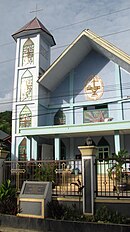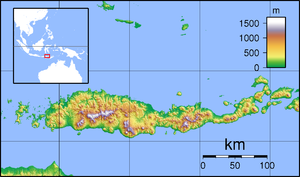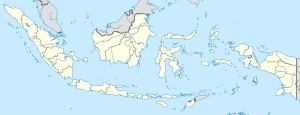Labuan Bajo
Labuan Bajo | |
|---|---|
 View of the port of Labuan Bajo | |
Location in Indonesia | |
| Coordinates: 8°30′S 119°53′E / 8.500°S 119.883°E | |
| Country | Indonesia |
| Region | Lesser Sunda Islands |
| Province | East Nusa Tenggara |
| Regency | West Manggarai |
| Population (mid 2022 estimate) | |
| • Total | 6,987 |
| [1] | |
| Time zone | UTC+8 (WITA) |
Labuan Bajo is a fishing town located at the western end of the large island of Flores in the East Nusa Tenggara province of Indonesia. It is in Komodo district.[2] It is the capital of the West Manggarai Regency, one of the eight regencies of Flores.
Toponymy[edit]
The name Labuan Bajo is taken from the large number of Bajo tribes that live on the coast.
Tourism[edit]
Once a small fishing village, Labuan Bajo (also spelled Labuhanbajo and Labuanbajo) is now a tourist center as well as a centre of government for the surrounding region.[3]
Roads link Labuan Bajo to other towns across Flores such as Ruteng, Bajawa, Ende and Maumere.
The town is small and can easily be traversed on foot in 15 minutes. Mirror stone cave (gua Batu cermin) is only 5 km north-east of the marina.[4][5] Nearby Labuan Bajo are several waterfalls, trekking, and diverse beaches. Wae Rebo Village, 5 hours away by car and another 4.5 km on foot, can be visited to learn about the indigenous culture of the area. This World Heritage site is known for its traditional houses called Mbaru Niang.[6][7]
Beside these, 19 other places around Labuan Bajo are frequently listed as touristic sites: Gili Laba, Rinca Island, Komodo Island, Kanawa Island,
Padar Island, Lingko Rice Fields,
Kelor Island, Kelimutu Lake, Ranko Cave, Cunca Lawang, Bena Traditional Village, Manta Point,
Pink Beach, Bidadari Island, Seraya Island,
Kalong Island, Melo Village,
Pede Beach, and Sano Nggoang Lake.[8]
-
Padar island
-
Kelor island
-
Pink beach
-
Bats and sunset at Kalong island
-
Pede beach
Komodo National Park[edit]
Labuan Bajo is the gateway to the nearby Komodo National Park on and around Komodo Island and Rinca Island, both home to the famous Komodo dragons. The park is a World Heritage Site. Its islands offer good diving sites.
Every evening at Kalong Island (in the bay on the east side of Komodo island[9]), thousands of flying fox bats (known as burung kalong in Indonesian) rise from the mangroves and form a massive cloud that crosses the strait to Flores island in search of food.
Diving sites near Labuan Bajo[edit]
There are numerous diving sites in the islands close to Labuan Bajo - but in some places currents can be dangerously strong and much carefulness is required - notably at Batu Bolong site (whose name means "hole in the rock", in the Linta Strait), also called "Current City" for that reason[10][11] To the north are Sabolon kecil, Sabolon besar and Seraya kecil; to the west are Sebayur (outside Komodo park), Tatawa besar and Tatawa kechil (within the park[12]), Karang Makassar (Manta Point),[10] Kanawa[13] and many more.

Tourism development[edit]
The location of Labuan Bajo at the tip of Flores Island makes it the initial destination for incoming tourists.[14] It has been designated as a National Tourism Strategic Area (priority tourism destination) in the National Tourism Development Plan,[15] and as one of five super-priority tourism destinations established by the Indonesian Presidency[14] in 2018,[15] with an emphasis on providing essential tourism infrastructure and accommodation for visitors.[14] Facilities to support tourist activities are expanding quickly but the rapid rise in the numbers of visitors is imposing some strain on the local environment.[16]
Thus accommodations have increased in the area: in 2019, it included 13 five-star hotels, 68 non-star hotels, 4 villas, and 26 dormitories.[17] This has considerably increased the built-up surface, with a growth of 161 ha between 2011 and 2017, another 246 ha between 2017 and 2023, and it is expected to grow by 267 ha again by 2029.[14]
This is despite the fact that the area is prone to natural disasters, including tsunamis, earthquakes and landslides. These extreme natural phenomena are known to have a negative impact on the number of tourists and the tourist experience, and to have a greater influence on the number of tourists than man-made disasters such as terrorist attacks.[15]
- Environmental effects
The development of the area brings a mounting trash problem: the Komodo National Park and its surrounding area, including the coastal area of Labuan Bajo, can compile in one day an average of 13 tons of trash, of which 35 to 40 percent is inorganic waste that contains saleable plastic waste.[16]
There are also the matters of illegal fishing and coral vulnerability,[16] while the basis of the decision regarding what is legal and illegal may be questioned: the local community has been fishing in these waters for centuries and did no damage; but since the creation of the national park they have been outlawed, and have been excluded from the decision-taking entities.[18] In the later part of 20th century, some fishermen did start using destructive methods such as explosives or chemicals; explosives are still used (2024).[19]
- Socio-economical effects
Touting the tourism development as having a great impact on the local economy[17] is certainly true, but not necessarily in the way it is meant to be. A 5-part documentary in 2023 by director Dandhy Laksono has highlighted the flaws that have so far remained hidden from tourists: marginalization of local people, denial of indigenous peoples' rights, privatization of coastal areas and water resources, destruction of forests, control by big business players with strong political connections, and the resistance by residents to defend their living space. Thus tourism developments in Labuan Bajo offers little benefit to the local people; they are designed for outsiders and the interests of local residents are neglected. One tourist guide observed that "several corporations have obtained permits to open hotels and resorts over hundreds of hectares. One day big companies will control Komodo Island"; and he predicts that "ten years from now (2023), the Ata Modo indigenous people that inhabit Komodo Island will be reduced to living in cramped spaces."[20] Those people have lived on Komodo island for over a thousand years, but in the name of tourism development the gouvernment has declared them to be "wild settlers" and wants them out: in the national park, "There will be no human rights, only animal rights," says governor Victor Laiskodat[18] Which raises questions about the existence of the luxury Komodo resort[a] on Sebayur Besar island.
Land speculation and sell-out is rife.[22]
In regard to employment, tourism development has created job opportunities for the local population;[17]
but a 2017 assessment underlined
the low wages,[23][b]
the high proportion of businesses which do not fully comply with labour laws,
insufficient provision of social security throughout the industry and a lack of structured efforts in staff training - which limits career perspectives.[22] All in all, the revenue increase often touted for the area[17] does not globally profit the local population and the contribution to poverty reduction remains marginal; nor is there any indication for infrastructural improvements which benefit the local population in significant ways.[23]
One aspect of this tourism development is the increase of imbalance between the well-developed centre of Indonesia and its lesser developed periphery. Only 1/3 of business owners are Florenese, and they mostly own small businesses with low margins who face the strongest competition, such as budget accommodations and tour operators. The large proportion of ownership by outsiders, in conjunction with these outsiders owning the businesses with the highest profits, presents a significant source for financial leakage.[24] This assessment was published in 2017. Since then the leakage situation has worsened: there has been the opening in September 2018 of the first five-star luxury resort Ayana Komodo (205 rooms), a Marriott hotel with the Ta'aktana resort, AccorHotels, Alila[25] and possibly others.
Transport[edit]

Komodo Airport is located just 2 km from the center of Labuan Bajo and has 4–6 daily flights arriving from Denpasar in Bali and elsewhere. Labuan Bajo port has daily ferry departures to the town of Bima to the west on the large island of Sumbawa and weekly or bi-weekly departures to Denpasar and Sulawesi. There are also direct flights from Jakarta to Labuan Bajo by Garuda Indonesia and Batik Air.
Economy[edit]
The local economy in the town is centred around the ferry port and tourism, local shops and restaurants, and the diving trade. Most of the foreign tourists are European, many from Italy, and also from Australia and the United Kingdom. The wider area produces fish and palm oil; there is also a large amount of subsistence agriculture in the villages in the region where living standards are still low. Levels of poverty in the rural areas are high.
The national and regional governments made 2012 a year to promote regional tourism around Labuan Bajo and the nearby Komodo National Park with a six-month festival from July until December 2012.[26]
Climate[edit]
Labuan Bajo has a dry "winter" tropical savanna climate (Aw), with moderate to little rainfall from April to November and heavy rainfall from December to March.
| Climate data for Labuan Bajo | |||||||||||||
|---|---|---|---|---|---|---|---|---|---|---|---|---|---|
| Month | Jan | Feb | Mar | Apr | May | Jun | Jul | Aug | Sep | Oct | Nov | Dec | Year |
| Mean daily maximum °C (°F) | 30.4 (86.7) |
29.8 (85.6) |
30.5 (86.9) |
31.0 (87.8) |
30.8 (87.4) |
30.4 (86.7) |
30.4 (86.7) |
30.9 (87.6) |
31.5 (88.7) |
31.9 (89.4) |
31.5 (88.7) |
30.7 (87.3) |
30.8 (87.5) |
| Daily mean °C (°F) | 25.6 (78.1) |
25.3 (77.5) |
25.7 (78.3) |
25.8 (78.4) |
25.3 (77.5) |
24.7 (76.5) |
24.1 (75.4) |
24.4 (75.9) |
25.2 (77.4) |
26.0 (78.8) |
26.5 (79.7) |
26.0 (78.8) |
25.4 (77.7) |
| Mean daily minimum °C (°F) | 20.9 (69.6) |
20.9 (69.6) |
20.9 (69.6) |
20.6 (69.1) |
19.9 (67.8) |
19.0 (66.2) |
17.9 (64.2) |
17.9 (64.2) |
18.9 (66.0) |
20.2 (68.4) |
21.5 (70.7) |
21.3 (70.3) |
20.0 (68.0) |
| Average rainfall mm (inches) | 291 (11.5) |
274 (10.8) |
196 (7.7) |
103 (4.1) |
80 (3.1) |
42 (1.7) |
25 (1.0) |
24 (0.9) |
21 (0.8) |
46 (1.8) |
118 (4.6) |
205 (8.1) |
1,425 (56.1) |
| Source: Climate-Data.org[27] | |||||||||||||
Gallery[edit]
-
Main street
-
Saint Angela Church
-
Harbour
-
Masjid Agung Nurul Falaq
-
Labuan Bajo harbour
-
Main port building
Notes[edit]
- ^ Komodo resort on Sebayur Besar island is owned by PT Delos International Bali and J&J Neptune Alliance Limited, who also cover (independently of conjointly) the trademarks Komodo Resort, Komodo Sea Dragon, Neptune Scuba Diving, Hilltop Komodo Resort, Neptune One, Neptune Liveaboards and others.[21]
- ^ In 2017 32 per cent of interviewed businesses paid below the minimum wage and the majority paid around the minimum wage.[23]
References[edit]
- ^ Badan Pusat Statistik, Jakarta, 2023.
- ^ "Labuan Bajo village 86763". m.nomor.net. Retrieved 2024-06-10.
- ^ Benito Lopulalan, 'Growing Tourism on Flores' Archived 2012-04-29 at the Wayback Machine, The Jakarta Globe, 24 February 2009.
- ^ "Wonderful Indonesia - Gua Batu Cermin". Wayback Machine. Archived from the original on 4 March 2016. Retrieved 12 February 2018.
- ^ "Gua Batu Cermin, map". google.com/maps.
- ^ Suhandi, Ary Sendjaja; Novianti, Evi; Oktavia, Dina; Khan, Alexander M.A.; Simatupang, Wita P. (August 2022). "Community Participation Process in Community-Based Tourism Development in Waerebo Traditional Village, Manggarai Regency, Flores". ASEAN Journal on Hospitality and Tourism. 20 (2): 67–82. ISSN 2722-2748. Retrieved 2024-06-12.
- ^ "Wae Rebo village (Flores)". cyclingstew.com. Retrieved 2024-06-12.
- ^ Setiawan, Johan; Gousander, Vegeterrikin; Prasetiawan, Iwan (July 2023). "Unmasking the Sentiments of Labuan Bajo: An Instagram-based Analysis for Tourism Insights through VADER Sentiment Analysis". G-Tech : Jurnal Teknologi Terapan. 7 (3): 967-976 (see p. 971). Retrieved 2024-06-13.
- ^ "Pulau Kalong, map". openstreetmap.org.
- ^ a b "Diving near Komodo and Rinca Islands". starfish.ch. Retrieved 2024-06-10.
- ^ "Batu Bolong – Bucket List Dive Site". samataliveaboard.com. Retrieved 2024-06-10.
- ^ "Tatawa kechil (diving site), map". google.com/maps.
- ^ "Kanawa island : the hidden gem in Komodo". dragondivekomodo.com. Retrieved 2024-06-10.
- ^ a b c d Pertiwi, Titis Chris Monika; Saputra, Aditya (March 2024). "Landuse Change Prediction on Super-Priority Tourism Destination in Labuan Bajo, Indonesia". Web of Conferences. 500 (03043). Retrieved 2024-06-10.
- ^ a b c Widjaja, Herry Rachmat; Darmayasa, Muh.; Badollahi, Zainuddin; Ridwan, Masri; Musawantoro, Muh. (2022). "Disaster Management for Tourism Destination in Labuan Bajo (Case Study on Super Priority Destinations)" (PDF). Webology. 19 (2). Retrieved 2024-06-10.
- ^ a b c Markus Markur (7 September 2017). "Labuan Bajo faces challenges with rising tourism". The Jakarta Post. Retrieved 2024-06-10.
- ^ a b c d Kiwang, Amir Syarifudin; Arif, Farida M. (December 2020). "Perubahan Sosial Ekonomi Masyarakat Labuan Bajo Akibat Pembangunan Pariwisata". Gulawentah: Jurnal Studi Sosial (in Indonesian). 5 (2): 87–97. Retrieved 2024-06-10.
- ^ a b Dale, Cypri Jehan Paju; Afioma, Gregorius (October 2020). "Puzzling Confluence of Conservation and Ecotourism in Komodo National Park, Indonesia" (PDF). Japan-ASEAN Transdisciplinary Studies Working Paper Series (10). Retrieved 2024-06-10.
- ^ "Police Urges Labuan Bajo Coastal Residents To Not Use Fish Bombs". en.antaranews.com. Antara Indonesian news agency. 1 March 2024. Retrieved 2024-06-11.
- ^ "Film bares ill-effects of tourism on Indonesia's Flores Island". ucanews.com (about the documentary film Dragon for Sale). 28 April 2023. Retrieved 2024-06-10.
- ^ "Komodo resort, legal info". komodoresort.com. Retrieved 2024-06-10.
- ^ a b Remmer, Stefanie; Achmad, Ibnu (April 2017). Tourism Impacts in Labuan Bajo (PDF). Swisscontact WISATA. pp. 68 (Appendix 1: Impact summary, p. 1).
- ^ a b c Remmer & Achmad 2017, p. 69 (Appendix 1: Impact summary, p. 2.
- ^ Remmer & Achmad 2017, p. 16.
- ^ "Tourism's the 'new giant' for Labuan Bajo". globalexpatrecruiting.com. 21 November 2018. Retrieved 2024-06-10.
- ^ 'E. Nusa Tenggara to hold Komodo Festival', Antara News, 21 October 2011.
- ^ "Climate: Labuan Bajo". Climate-Data.org. Retrieved 18 November 2020.
External links[edit]
 Labuan Bajo travel guide from Wikivoyage
Labuan Bajo travel guide from Wikivoyage













